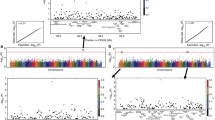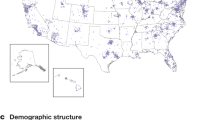Abstract
The domestic dog (Canis familiaris) shows greater phenotypic variation than any other mammal. A corollary of this variation has been the recognition of more naturally occurring inherited diseases in dogs than have been cataloged in any other species apart from man. Recent catalogs list more than 370. A searchable Web-based database “Inherited Diseases in Dogs” (http://www.vet.cam.ac.uk/idid) has been developed. It catalogs diseases and conditions of dogs which are likely to be transmitted wholly or partly through a genetic mechanism, together with breeds in which they have been described. It contains disease listings and short descriptions, genetic and molecular genetic summaries where known, and connects to entry points to the literature on each disease.
Similar content being viewed by others
Avoid common mistakes on your manuscript.
The domestic dog (Canis familiaris) shows variation in body size and anatomical conformation greater than those seen in any other mammalian species, often combined with considerable heritable differences in behavior patterns. This phenotypic variation breeds true within the pedigree or pure-bred breeds, which are genetically isolated subgroups of the entire canine population. A corollary of phenotypic variation has been the recognition of more naturally occurring inherited diseases in dogs than have been cataloged in any other species apart from man. There are at least 370 in recent catalogs (Ostrander et al. 2000; Patterson 2000), and over 130 show simple Mendelian inheritance (Brooks and Sargan 2001). Both of these figures now seem likely to be substantial underestimates. A new catalog is also timely in view of the publication of a 1.5× shotgun sequence for the dog (Kirkness et al. 2003) with further sequencing in progress and with the rapid recent advance in integrated canine meiotic, radiation hybrid, and cytogenetic maps (Breen et al. 2003; Guyon et al. 2003), as well as the rather complete comparative synteny information for the species (Breen et al. 1999; Sargan 2000).
Genetic diseases in dogs have both veterinary and comparative importance. Genetic diseases are among the most common causes of morbidity seen by veterinarians, while differences in mortality from a variety of diseases with large genetic components contribute heavily to differences of more than 50% in average life expectancy between breeds. Diseases in the dog are especially important as intermediate models of human diseases because of the relatively long life and large size of this species and the very close similarity in tissue function for many tissues. The majority of canine inherited diseases (at least 215) are also of comparative interest to human medicine. Dogs have been used extensively to model both prophylaxis and treatment modalities for human disease, ranging from surgical and pharmacological to gene therapies. Nevertheless, the dog is still a little-known species for most geneticists. Until recently it has been an orphan species in terms of funding and is under-investigated in relation to its importance in society, to veterinary medicine, and for comparative purposes.
Resource
The Inherited Diseases In Dogs website (http://www.vet.cam.ac.uk/idid) connects an HTML front page to two Filemaker Pro 4 databases. These databases are interconnected through searchable fields listing inherited disorders and breeds as well as through a keyword search tool. The first database contains separate records, each documenting one disease occurring in one breed. In addition to breed name and disease fields, each record contains alternate disease names; a short clinical, pathological, and/or biochemical description; reference fields connecting to the second Filemaker Prodatabase; and a set of hyperlinks to the Online Mendelian Inheritance in Man (OMIM) database. The second database manages each reference as a separate record, hyperlinking it to the relevant PubMed abstract or to other databases such as online open disease registries. From the front pages, breeds or diseases (or both) are searchable using drop-down menus, while the whole site can be searched for occurrences of any keyword which is found within it (Fig. 1A). These searches display results as concise records (without full genetic explanations or references) (Fig. 1B). Clicking on a button beside the concise record produces the full record (Figure 1C). The entire database can also be browsed, viewing up to 50 records at a time.
Three screen shots from the database. (A) The search page. (B) Part of search results for a breed (German Shepherd dog). Scrolling allows viewing of concise records for all 39 listed diseases in this breed. (C) Detailed result for a disease obtained by clicking a “more info” button on screen B (exocrine pancreatic insufficiency in the German Shepherd dog). Again, this screen is scrollable to further references and OMIM links.
Discussion
The Inherited Diseases In Dogs (IDID) website (http://www.vet.cam.ac.uk/idid) attempts to make canine genetic disease more accessible to the working scientist. It catalogs diseases and conditions of dogs that are likely to be transmitted wholly or partly through a genetic mechanism together with breeds in which they have been described. It contains disease listings and short descriptions; genetic and molecular genetic summaries if known; and entry points to the literature on each disease. Short comments are included on each entry, written largely in clinical and genetic language [although these are not as extensive as those for human disease in Online Mendelian Inheritance in Man (OMIM) (http://www.ncbi.nlm.nih.gov/omim)]. References to relevant literature are linked directly to PubMed (http://www.ncbi.nih.gov/entrez/query/fcgi?db=PubMed), while those references to open registries are linked to those registries. Records are also linked to OMIM entries describing equivalent human diseases (this group of links is still expanding). In this respect the site compliments Online Mendelian Inheritance in Animals (OMIA) (http://www.angis.su.oz.au/Databases/BIRX/omia/), which does not have these direct links. The OMIA and IDID sites are not coextensive because IDID has been more critical than OMIA in its definition of “inherited disease” and it has not included many diseases which may have solely environmental or infectious causes; nor did IDID include many single-case reports which were not shown to be inherited conditions. Conversely, there is more detailed coverage of some diseases. Reference lists in IDID are not yet exhaustive; work is continuing to make them more complete.
The IDID site is also complementary to The Canine Inherited Disorders Database (CIDD) (http://www.upei.ca/∼cidd/intro.htm), a site that reviews canine inherited diseases and that is directed primarily at the owner and the veterinarian. It has complete disease summaries in lay language, but it does not have comparative links and has far fewer references to primary literature. Many dog breed-specific or disease-specific web sites also contain disease descriptions. Connections are offered from a links page within IDID to CIDD and several other canine disease sites.
The IDID site is restricted to diseases that have been documented in the peer-reviewed scientific literature or through breed or disease registries. To be included, disease must show either a simplex or clearly familial pattern of occurrence or a strong breed predisposition. The latter must be evidenced by a markedly increased odds ratio of the disease occurring in that breed when compared with the general dog population. (Except where noted, an odds ratio of >5:1 between breed-specific and control incidence has been used, with lower confidence limit >1.) For a number of more common defects (e.g., hip dysplasia, elbow luxation) that occur in many breeds, we have arbitrarily chosen to record the 20 breeds with the highest breed prevalence as recorded in open registries, together with breeds for which more detailed genetic workup has been performed.
At the time of writing, there are over 1080 entries of disease with breed and the underlying database contains 479 disease fields. Neither of these numbers truly represents the number of separate inherited disease entities. The difference between them illustrates the occurrence of many diseases in more than one breed, while the author may not always have recognized when the same disease occurs under more than one name, causing exaggeration of both numbers. Conversely, many rather similar clinical conditions may have more than a single genetic origin either within a breed or between breeds. The IDID lists of diseases, breeds, and references are all still incomplete, with the databases being revised every few weeks. Single-case records of diseases have been documented on the site only when there is clear probability for inheritance, although we have used groups of single-case records to provide that evidence in some cases. In the long term, we intend to update the site at least every four months. The author would welcome e-mailed corrections of inaccuracies and omissions. Ideally, the latter should include a short description of the disease and the breed(s) in which it occurs, and one or more references to peer-reviewed literature.
References
EA Ostrander F Galibert DF Patterson (2000) ArticleTitleCanine genetics comes of age Trends Genet 16 117–124 Occurrence Handle10.1016/S0168-9525(99)01958-7 Occurrence Handle1:CAS:528:DC%2BD3cXhsFOisL0%3D Occurrence Handle10689352
DF Patterson (2000) ArticleTitleCompanion animal medicine in the age of medical genetics J Vet Intern Med 14 1–9 Occurrence Handle10.1111/j.1939-1676.2000.tb01492.x Occurrence Handle1:STN:280:DC%2BD3c7jt1antg%3D%3D Occurrence Handle10668810
M Brooks DR Sargan (2001) Chapter 9: Aspects of Genetic Disease A Ruvinsky J Sampson (Eds) Canine Genetics CABI Oxford 191–266
EF Kirkness V Bafna AL Halpern S Levy K Remington et al. (2003) ArticleTitleThe dog genome: survey sequencing and comparative analysis Science 301 IssueID5641 1898–1903 Occurrence Handle10.1126/science.1086432 Occurrence Handle14512627
M Breen S Jouquand C Renier CS Mellersh C Hitte et al. (2003) ArticleTitleChromosome-specific single-locus FISH probes allow anchorage of an 1800-marker integrated radiation-hybrid/linkage map of the domestic dog genome to all chromosomes Genome Res 11 IssueID10 1784–1795 Occurrence Handle10.1101/gr.189401
R Guyon TD Lorentzen C Hitte L Kim E Cadieu et al. (2003) ArticleTitleA 1-Mb resolution radiation hybrid map of the canine genome Proc Natl Acad Sci USA 100 IssueID9 5296–5301 Occurrence Handle10.1073/pnas.0831002100 Occurrence Handle1:CAS:528:DC%2BD3sXjs1yitrc%3D Occurrence Handle12700351
M Breen R Thomas MM Binns NP Carter CF Langford (1999) ArticleTitleReciprocal chromosome painting reveals detailed regions of conserved synteny between the karyotypes of the domestic dog (Canis familiaris) and human Genomics 61 IssueID2 145–155 Occurrence Handle10.1006/geno.1999.5947 Occurrence Handle1:CAS:528:DyaK1MXmslyitrk%3D Occurrence Handle10534400
DR Sargan F Yang M Squire BS Milne PC O‘Brien et al. (2000) ArticleTitleUse of flow-sorted canine chromosomes in the assignment of canine linkage, radiation hybrid, and syntenic groups to chromosomes: refinement and verification of the comparative chromosome map for dog and human Genomics 69 IssueID2 182–195 Occurrence Handle10.1006/geno.2000.6334 Occurrence Handle1:CAS:528:DC%2BD3cXnt1Wjt7s%3D Occurrence Handle11031101
Acknowledgments
The author wishes to acknowledge the help of Dr. Marjory Brooks (James A. Baker Institute of Animal Health, Cornell University) in the initial stages of compiling the content of the database, of Helen Sargan in designing the web interface, and of Janet Smith in helping to populate the databases.
Author information
Authors and Affiliations
Corresponding author
Rights and permissions
About this article
Cite this article
Sargan, D.R. IDID: Inherited Diseases in Dogs: Web-based information for canine inherited disease genetics. Mamm Genome 15, 503–506 (2004). https://doi.org/10.1007/s00335-004-3047-z
Received:
Accepted:
Published:
Issue Date:
DOI: https://doi.org/10.1007/s00335-004-3047-z





